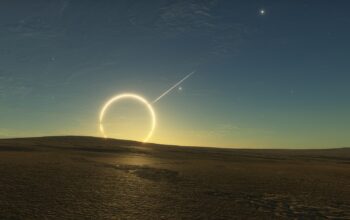The concept of an ekpyrotic universe has garnered renewed attention within the cosmological community, particularly as debate surrounding the origins of the universe evolves. The ekpyrotic model offers a compelling framework, proposing that our universe could emerge from the collision of two three-dimensional branes within a higher-dimensional space. This theory not only proposes a novel genesis for the universe but also suggests transformative implications for our understanding of cosmic evolution.
The ekpyrotic scenario is laden with philosophical and scientific ramifications. Traditionally, models of cosmic genesis have relied upon singular events known as Big Bangs—cataclysmic expansions from a singular point. However, the ekpyrotic model shifts this narrative to one of colliding worlds. Instead of a singular birth, the universe’s existence is perceived as an ongoing process, rooted in complex interactions between higher-dimensional structures. Embracing this paradigm poses profound questions about reality and our place within it.
At the crux of the ekpyrotic hypothesis lies the notion of branes, or membranes, which are extended objects in string theory. In this scenario, our universe is theorized to exist on one of these branes, while another parallel brane exists nearby. The collision of these branes, when orchestrated under specific conditions, can release a tremendous amount of energy, resulting in the formation of a hot, dense universe that subsequently evolves into what we observe today. The interplay between these branes creates a unique set of cosmological phenomena, diverging dramatically from conventional big bang cosmology.
One of the most alluring aspects of the ekpyrotic model is its implication for the homogeneous and isotropic nature of our universe. Observations reveal an uncanny uniformity in the cosmic microwave background radiation, which serves as a remnant signal from the early universe. An ekpyrotic origin elegantly accounts for this isotropy without necessitating the introduction of inflationary phases—unlike traditional models. Instead, the collision event theoretically blurs any spatial irregularities that might have existed prior, resulting in a smoother overall structure.
One might inquire about the implications of such an origin on cosmic fate. An ekpyrotic universe does not necessarily signal permanence. Instead, it hints at an oscillatory misconduct of reality—a cyclic essence where successive collisions can occur, leading to myriad epochs of creation and destruction. This cyclicity invokes intriguing questions about the ultimate fate of not only our universe but also potential universes that might coexist along similar planes. The exploration of dark energy, gravitational waves, and other exotic phenomena further enriches our understanding of this complex tapestry.
Nevertheless, challenges remain in establishing the viability of an ekpyrotic model. One predominant concern is the compatibility of this framework with current observational data. The fine-tuning required for the brane collision events to yield our universe calls for an intricate calibration of initial conditions—one that must align with established physical laws. Researchers must continue to probe whether empirical evidence can substantiate the hypotheses inherent within the ekpyrotic paradigm.
The mathematical underpinnings of ekpyrotic cosmology are equally as intricate. The model is grounded in higher-dimensional theories such as string theory and M-theory, leading to a complex interplay of forces and particles. Calculating the dynamics of colliding branes invites sophisticated mathematical constructs that can challenge even seasoned theorists. Fusion of these mathematical models with observational data constitutes the vanguard of contemporary cosmological research.
Furthermore, the implications of the ekpyrotic scenario extend beyond mere cosmic origins. The mechanism for structure formation, or how galaxies, stars, and planets developed, acquires a nuanced enhancement through this lens. In ekpyrotic cosmology, primordial perturbations arise naturally from brane dynamics. Such fluctuations could develop a rich tapestry of structure in the universe, guiding the formation of galaxies and cosmic structures, thereby helping scientists reconcile the observed universe’s grand tapestry with theoretical predictions.
Beyond cosmology, the entropic considerations of ekpyrotic models provoke philosophical inquiry into the nature of existence itself. The idea that the universe undergoes repeated cycles of creation raises existential questions about time, causality, and destiny. If cosmic epochs are cyclical, what does that imply about meaning and continuity within the universe? It invites profound reflection on the transient nature of existence and the potential for consciousness to grasp the reality of an eternal cosmos.
As the scientific community delves deeper into these multifaceted inquiries, the ekpyrotic model stands at the precipice of redefining our understanding of cosmology. Its promises extend from a potential shift in perspective on the origins of the universe to its behaviors, structures, and ultimate fate. The resurrection of such theories in the wake of increasing empirical evidence and exploration illustrates the enduring quest for knowledge that characterizes the pursuit of understanding our universe.
In conclusion, ekpyrotic cosmology exemplifies the richness of contemporary scientific inquiry, intertwining cosmological phenomena with an exploration of existence itself. The possibility that our universe may be a mere byproduct of interdimensional encounters stirs the imagination, inviting both skepticism and enthusiasm. As researchers continue to unravel the complexities of this model, the promise of new insights into the essence of the cosmos beckons, enriching our collective curiosity and understanding of the universe’s enigmatic origins.










